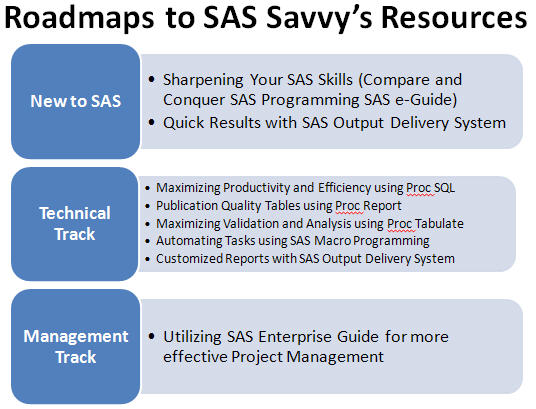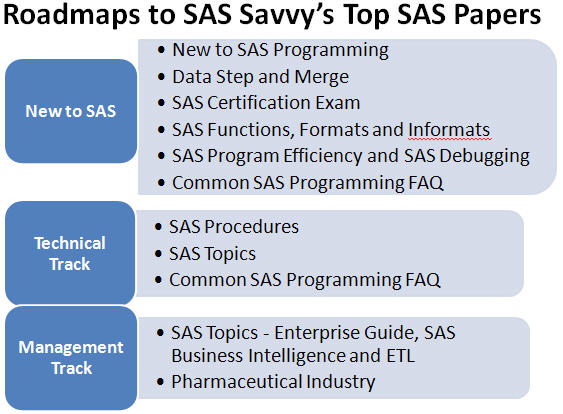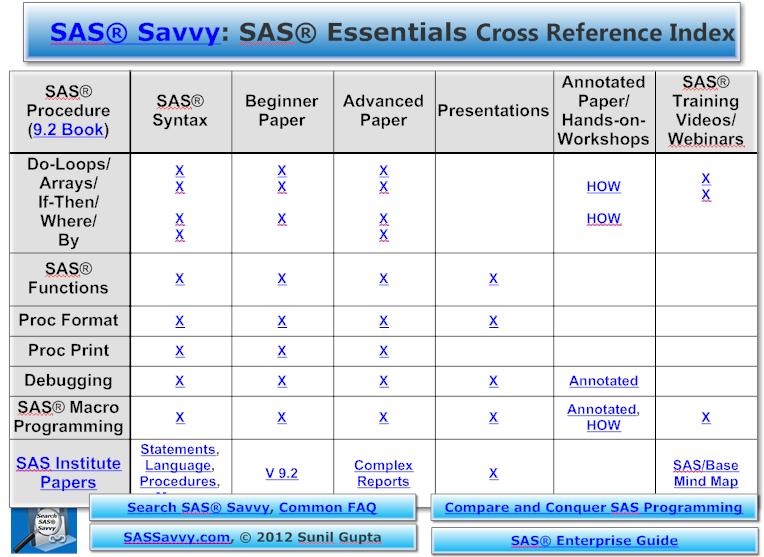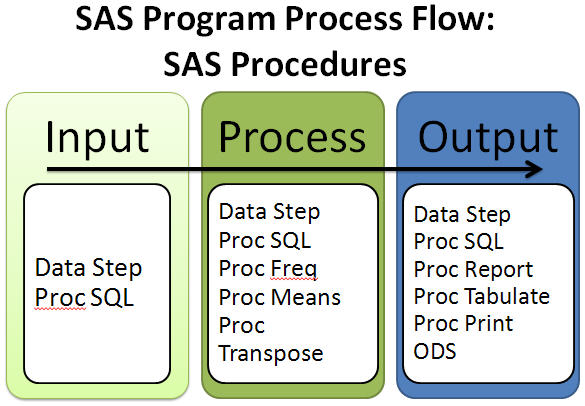New SAS® Programmer

SAS University Edition - Access to SAS free for learning (Support Site, Download)
This page shows how to best utilize SAS® Savvy's collection of links to top SAS papers and resources. For those who are new to SAS® Programming, this page shows the road map to select papers based on SAS® procedures, SAS® topics or summary sheets based on your SAS question. It is strongly recommended to start with the Savvy Training Videos.
From the process flow diagram to the three pathways, New to SAS®, Technical Track and Managment Track, you should be able to quickly locate your focused answer. In addition, you will find helpful Top Beginner Papers and Top SAS® References to quickly introduce you to SAS Programming, the SAS Procedures or SAS topic.
Finally, there are also sections such as effective programming style and communication skills for SAS® Programmers working abroad. Download conference trip report to make the most of your SAS conference experience. See also New Clinical SAS Programmer, SAS Enterprise Guide, SAS Certification and Debugging.

See Savvy Training Videos, Newsletter, Examples, Presentations and Tip Sheets
Topics include Common SAS Programming FAQs, SAS Programming/Base Certification, Companions to Proc SQL e-Guide, Proc Tabulate e-Guide, and SAS Macro Programming e-Guide. Look for SAS papers and references appropriate for your SAS Programming level. Build a solid foundation on comprehensive understanding. Learn SAS through MindMaps.
Beginner SAS Programmer |
Advanced SAS Programmer |
Macro SAS Programmer |


The Little SAS book (pdf) (examples)
SAS Programming by Example (examples)
SAS® Terms: Merge/Join, Lookup
SAS ® Examples: Sample SAS Programs from SAS Books, DATA Step Examples
PROC XXX: Choosing the Right SAS Procedure
On-Line SAS Manual: Step-by-Step SAS Programming,Learning SAS By Example, A Programmer's Guide
Efficient Way to Learn SAS with Virtually No Cost (Paper)
Introduction to SAS 9
SAS Institute Links for free tutorials
Demystifying and resolving common transcoding problems, SAS Blog
Getting Started with SAS Video
SAS for Professionals OnDemand Tasks (Help Center)
| Task | Steps |
|---|---|
Access dataset from PC | Tasks > Data > Upload Data Files to Server (This will save dataset in WORK libname. Access using WORK.XXX) |
| Save dataset to PC | Tasks > Data > Download Data Files to PC > Select dataset > Select path (This will save dataset as permanent dataset on PC. Can access in SAS EG) |
| Set to create RTF files | Options > Results General settings > RTF as the default |
| Export RTF file to PC | Write SAS code, ex. Proc Print to write to RTF file. From RTF Results window > Export RTF Program > Select path |


Savvy Resources: How exactly are SAS e-Guides unique?,Getting Started Presentation
SAS Programming Basics
SAS® Essentials, Neil Howard
Leaming SAS by Diagrams and Examples, Joanne Peag, Shu-Yeag Wcmg
SAS® Shorts: Valuable Tips for Everyday Programming, Jeff McCartney, Raymond Hu
Quick Results with SAS® University Edition Software, Ryan Lafler, Kirk Lafler, Charles Edwin Shipp
SAS® Studio: A New Way to Program in SAS® Lora Delwiche, Susan J Slaughter
An Introduction to SAS Data Steps, SSCC

SAS Programming Style and Conventions
1. The Elements of SAS Programming Style, Frank DiIorio
2. SAS® Programming Conventions, Lois Levin
3. An Animated Guide: Coding standards for SAS® Production Programs, Russ Lavery
4. Good Programming Practice for Clinical Trials
5. If You Have Programming Standards, Please Raise Your Hand: An Everyman's Guide, Dianne Louise Rhodes
6. Plate of Spaghetti Anyone? Techniques for Learning Existing SAS® Programs, Tricia Aanderud
7. A Perfect Recipe to maintain SAS® programs, Shiva Srinivasan, Shailaja P Ramesh
8. SAS® Programming Guidelines, Lois Levin
9. Configuring SAS to Work for You, Part 2: More Programming Shortcuts, Kim Truett
10. Good Programming Practices in SAS, Jason Ford
11. Notes on Programming Style, Allan Glaser
12. SAS Programming Knowledge Management, Yajiang He
13. Free Online SAS Resources, Paul Grant
14. What makes a 'good' program?, Dean Grundy
15. What Makes a Good QC Programmer?, Timothy Harrington
16. SAS Essentials, Neail Howard
17. Learn SAS in 50 minutes, Subhashree Singh

SAS Programming and Career Tips
1. Secret Tools of the Ad Hoc Programmer, Robert Burnham, Kathryn Sabadosa, William Marble
2. 100 Things to Do in Your First 100 Days as a New SAS Programmer, Kari Kelso
3. Boot Camp for Programmers: Stuff you need to know that's not in the manual, Elizabeth Axelrod
4. Getting Up to Speed with SAS Version 9.2
5. Installing and Troubleshooting SAS 9.2
6. Coaching SAS® Beginner Programmers: Common Problems and Some Solutions, Peter Timusk
7. Creating SAS® Report Outline Using the Output Delivery System for Online Review, Sue X. Zhang
8. How to Grow a SAS® Programmer, Joanna Koft
9. Work Smarter Rather than Harder-Tools for Growing up A SAS® Programmer, Jiangtang Hu
10. Empowering SAS® Programmers: The Role of the Manager, Carey Smoak
11. What's Hot, What's Not: Skills for SAS® Professionals, Kirk Paul Lafler, Charles
Edwin Shipp
12. Therapy Lessons Learned to Empower Programmers, Shelley Dunn
13. A Day in the Life of Data - Part 3, Peter Crawford
14. What's New in SAS® Studio?, Mike Porter, Amy Peters, and Michael Monaco
15. What is a SAS Mentor and why do I need one?, Stanley Fogleman
16. What's a "Senior" SAS® Position?, Deb Cassidy
17. How to Get Promoted: Planning for Career Growth, Sandra Minjoe
18. A Day in the Life of Data – Part 1, Brian Bee
19. A Day in the Life of Data – Part 2, Harry Droogendyk
20. A Day in the Life of Data - Part 3, Peter Crawford
21. A Day in the Life of Data – Part 4, Sanjay Matange
22. The Well-Equipped Student: Using SAS® University Edition and E-Learning to Gain SAS® Skills
Randy Mullis, Allison Mahaffey and Parth Patel
23. New to SAS® and New to Programming? What You Need to Do Before Typing Code, Stephanie Thompson
24. SAS Consulting: New Beginnings, Charles Shipp, Kirk Paul Lafler
25. Adventures in SAS® Studio Lawrence Heaton-Wright
26. Developing Your Own SAS Studio Custom Tasks for Advanced Analytics, Elliot Inman and Olivia Wright
27. Introduction to SAS® Studio, Michael A. Monaco, Marie Dexter, Jennifer Tamburro
28. A Day in the Life of an Analytical Warehouse, Julian Anderson, Greg Barnes Nelson, Jeff Wright
29. How to Be an Organized SAS® Programmer, Jean Balent
(Download SAS program)
See SAS Technical Tips

SAS Animated Guide Series
An Animated Guide: Coding standards for SAS® Production Programs, Russ Lavery (program header)

On Boarding Tips for Corporations (See also Project Management)
1. Managing SAS® Technical Support in a Research Organization
2. Coordinated Efforts for Preparing Statistical Review Aids, Jian Wu, Snow Fu and Eric Zhang
3. Integration of SAS Macros and Web-Based User Interfaces, Jian Wu
4. A Simple, Inexpensive Solution to the Dilemma of SAS® Training, Erin Christen
5. A SAS ® Tip-of-the-Day Web Page on an Intranet, Bruce Gilsen
6. 10 SAS Skills for Grad Student Survival: A Grad Student "How-To" Paper, Elisa L. Priest
7. Successfully On-Boarding SAS® Analysts, Aaron Augustine
8. What is SAS Mentor and Why do I need one?, Stanley Folgeman
9. A CareerView Mirror: Another Perspective on Your Work and Career Planning, Bill Donovan
10. RECRUITING, INTERVIEWING AND HIRING A SAS® PROGRAMMING STAFF, Judith H. Mopsik, ARC Professional Services Group
11. Getting the User Community Involved in Education and Information Sharing, Russell Newhouse
12. Techniques for Managing Projects Outsourced to Offshore CRO, Hong Qi, Margaret Coughlin


Source: https://sassavvy.com/new_to_sas_programming.html
Posted by: patzaharchuke0198801.blogspot.com
Post a Comment